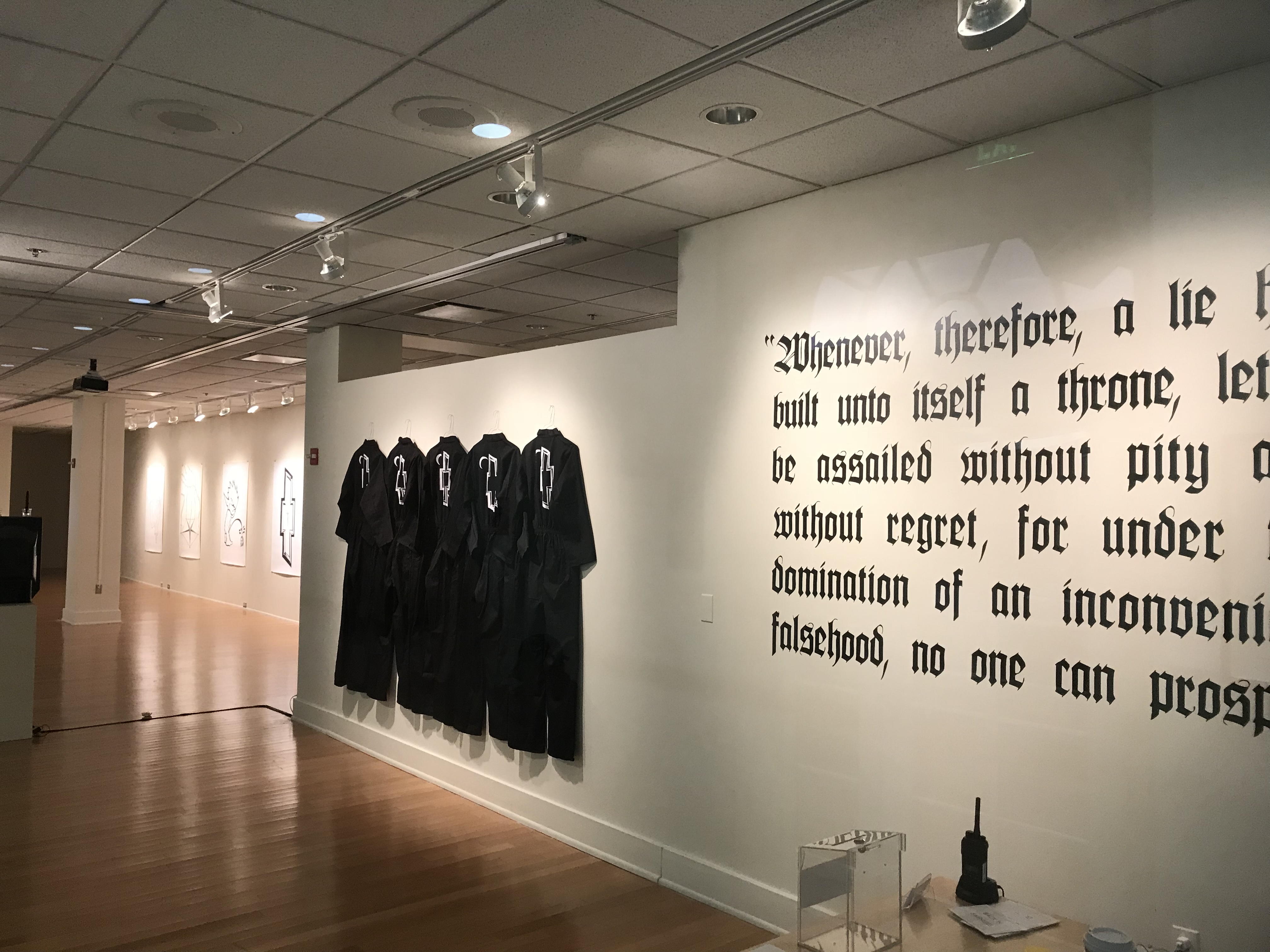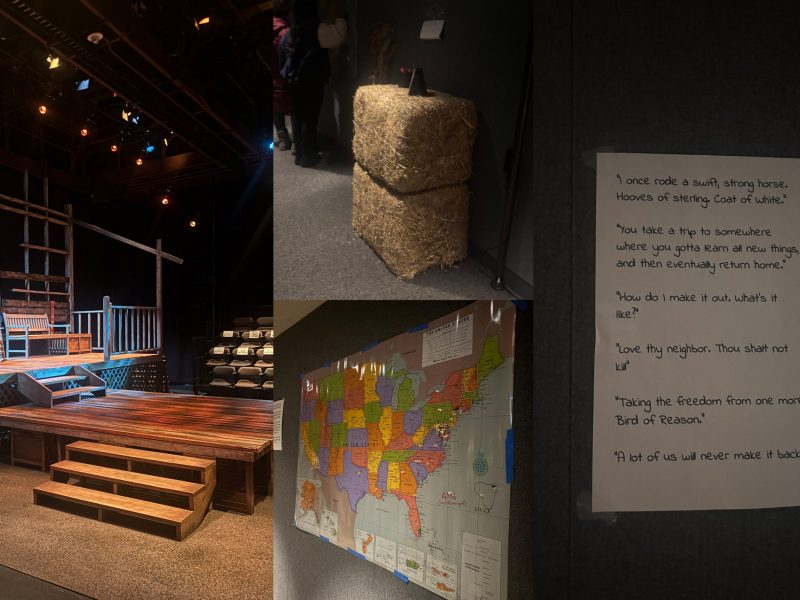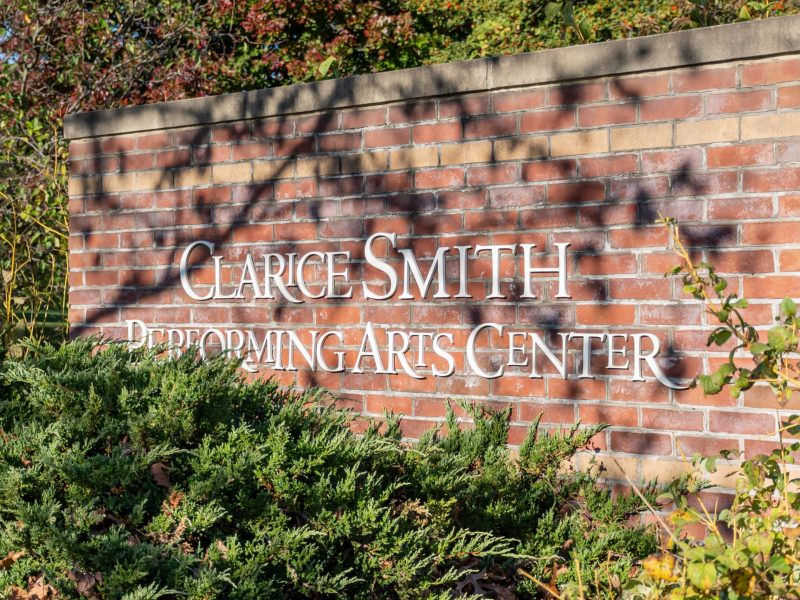A hairy claw dangles above your head, chained to a tree covered in tar. The sculpture is at once intriguing and deeply unsettling. One floor below, students laugh and chat as they decide if they want Panda Express or Taco Bell for lunch.
With contemporary art dominating much of the building, Stamp Student Union is not just a social hub, but an artistic one as well.
“False Monarchy” is the Stamp Gallery’s latest exhibition, featuring works from Kyle Kogut, a Philadelphia-based contemporary artist. The exhibition runs through March 17.
Kogut’s work focuses on labor in a capitalistic society, drawing parallels between American consumerism and cult-like behavior to showcase the frightening consequences of our relationship with heavy industry. The son of an auto mechanic, Kogut grew up around iconic logos of American exports and often uses this imagery in his work, juxtaposed against iconography of cult rituals and symbols.
Entering the exhibition, visitors are given the option to use a descriptive map. This map is the only way to find information about the works, as the more traditional labels typically displayed next to gallery pieces are not included.
“The idea was that when somebody walks into the exhibition they don’t necessarily feel like they’re in an art gallery but they feel like they’re in a space where an event has just happened or an event is about to occur,” said Grace DeWitt, a senior animal sciences and studio art major, and the student manager of the gallery.
Performance and sound are key aspects of this unique exhibition. The opening reception in January involved the staging of a performance where hooded figures chanted in the gallery as guitar blared. DeWitt, who served as one of the hooded figures that night, was instructed to hand out animal crackers to patrons as a sort of Eucharist.
“[Almost] everyone … accepted, even if I could tell they were uncomfortable,” DeWitt said. “And people would even automatically smile at me as I approached them.”
As viewers peruse the gallery, their visit is accompanied by drone music, electronic ambient sounds with long passages of feedback. The low, constant tones are eerie and strangely comforting.
“Some drone music is literally just a note for half an hour or buzzing,” said Raino Isto, the curator of the exhibition and also a coordinator at the gallery. “[The music in the exhibition] has kind of recognizable riffs in it, which is why I might describe it as drone metal as opposed to just drone.”
As curator, Isto worked closely with Kogut, helping guide the artist’s work in a particular direction. He encouraged the artist to take advantage of the gallery’s space. According to Isto, Kogut produced almost every piece featured in the exhibition within the past six to seven months.
Isto, who has worked at the gallery for the past two years, knows there are positives and negatives involved in running art exhibitions in a student union space.
“[Sometimes] people don’t realize what the Stamp Gallery is and so they just think that … the space must be rented out for some weird thing,” he said. “But I think the nice thing about this [location] is that people are in Stamp to do other kinds of things … and they can encounter the gallery in a way that’s different.”
Unlike the Herman Maril gallery, situated in the Art-Sociology Building, the Stamp Gallery does not always attract an arts-oriented crowd. Often, those encountering art in the Stamp Gallery do not expect it to be there at all.
“I think that [the Stamp Gallery is] trying to fulfill the type of contemporary art that wants to be breaking out of the walls of the museum,” said Isto. “It relies on the potential of people encountering it whether or not they like it [or] are ready to encounter it. … We offer people the sudden ability to have that experience.”
The Stamp Gallery is not the only place you can find art in the student center. In fact, Stamp’s Contemporary Art Purchasing Program has been bringing art to Stamp since 2006. Every two years, the program selects a group of student curators who are able to attend galleries in order to select art that they believe should be brought to the University of Maryland.
“I think the program is a way to really engage the university community,” said Eldis Sula, a program alumnus. “It can engage all the students and employees who are just passing through Stamp everyday.”
Through participation in the program, Sula got to witness firsthand the positive impact of contemporary art in campus spaces.
“A lot of people just tend to think of [art] as something old or something obscure or something closed off from everyday people,” he said. “I think art is for everyone and I think the importance of having contemporary art is to … give a sense that art is living.”



